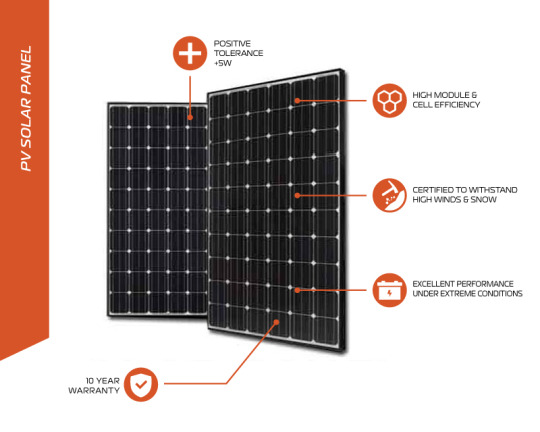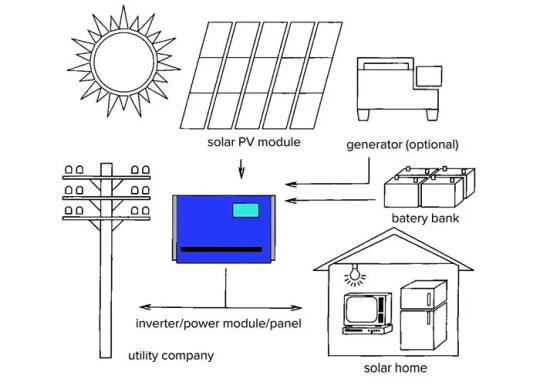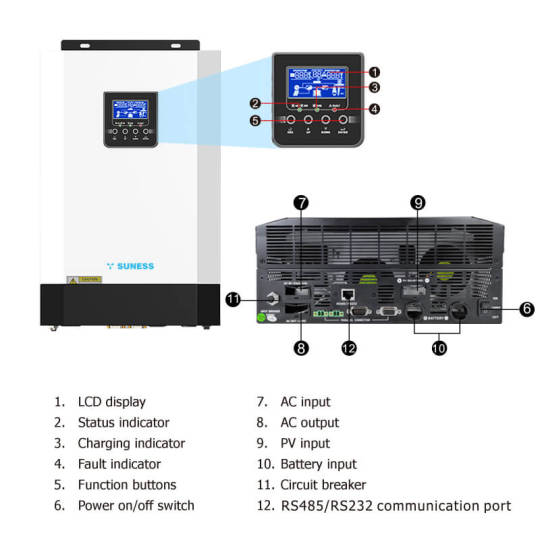#solar photovoltaic system
Text
Tailored Solutions: Find the Perfect PV Solar Panel System for Your Needs

In today's world of rapid transformation, the necessity to switch to sustainable energy alternatives has become more pressing. To minimize their carbon footprint and employ renewable energy sources, households as well as companies can now do so with the help of inexpensive and practical Residential Solar Panels.
0 notes
Text

☀️ Harness the power of the sun with Earthtrack's high-performance PV solar panels! Built tough to withstand extreme conditions, they come with a 10-year warranty for peace of mind. Featuring positive tolerance, high efficiency, and excellent performance, our panels deliver reliable power output. Trust Earthtrack for quality and durability. 🌟
#pv solar panel#most efficient solar panels#pv panels#solar pv#photovoltaic panels#solar pv system#photovoltaic system#commercial solar panel#solar panels system#commercial solar panels for sale#solar photovoltaic system#pv panels for sale#solar pv suppliers#solar pv near me#best commercial solar panels#solar pv companies#commercial solar panel manufacturers#commercial pv installations#photovoltaic panels for sale#pv solar power#solar photovoltaic panel#pv solar power system#commercial solar pv#solar pv panel system#photovoltaic power system
0 notes
Video
youtube
Hybrid solar inverter
0 notes
Text
Solar Photovoltaic System Training Kit
Solar Photovoltaic System Training Kit is designed to simulate the operation of solar photovoltaic system to transform solar energy into power electric through silicon cells.Solar Photovoltaic System Training Kit can meet the experiments,teaching and researching requirements of solar cell performance testing and photovoltaic applications in relevant professional and curriculum such as solar technology,photovoltaic technologies and its applications,photovoltaic equipment manufacturing and maintenance,photovoltaic materials processing and application technology and etc.in college,technical schools and institutes.Solar Photovoltaic System Training Kit allows users to monitor, control and hands-on learning about the principles and operation of a solar photovoltaic harvesting system.Solar Photovoltaic System Training Kit consists of photovoltaic modules, solar controller, off-grid inverters, battery, test unit and other components.
#PHOTOVOLTAIC#SOLAR#SOLAR SYSTEM#SOLAR TRAINER#teaching apparatus#educational equipments#technical training equipments and lab supplies
0 notes
Text
Semi-Transparent Perovskite Solar Cells: A Window to the Future of Energy
Introduction
In a groundbreaking leap toward sustainable energy, scientists in South Korea have unveiled a remarkable advancement: semi-transparent perovskite solar cells that could revolutionize the way we harness sunlight. Imagine windows that not only let light in but also generate electricity! In this article, we delve into the fascinating world of semi-transparent solar technology,…

View On WordPress
#2d perovskite passivation#building integrated photovoltaics (BIPV)#clear solar panels for windows#energy harvesting windows#lithium ion battery technology#perovskite solar cell cost#perovskite solar cell degradation#perovskite solar cell efficiency#rooftop solar panel system cost#self charging smart glasses#semi transparent solar panels price#smart glass applications#transparent photovoltaic panels#transparent solar cell technology#transparent solar cells
0 notes
Text
What functions does a solar inverter serve?
In the realm of PV systems, inverters stand out as the primary orchestrators of operational functionalities, surpassing other components in their pivotal role. Their responsibilities have expanded significantly, especially with the evolution of smarter systems that boast heightened interactions with the utility grid. As solar technologies advance, inverters take on an increasingly multifaceted role, overseeing a spectrum of tasks critical to the seamless integration and performance optimization of photovoltaic installations.

Transformation from DC to AC Power
At its core, the primary role of an inverter lies in the transformation of the electrical output from solar panels, converting direct current (DC) power into the more widely applicable alternating current (AC) power. This pivotal conversion ensures that the energy harnessed from the sun, in its original form, is seamlessly adapted for use in households, commercial establishments, or seamlessly integrated into large-scale grid projects, such as expansive utility-scale solar arrays. This fundamental function highlights the inverter's crucial role in bridging the gap between solar energy generation and diverse electricity consumption needs.
Optimizing Power Generation
Inverters play a crucial role in the continuous monitoring and optimization of power output from solar arrays. Their responsibility extends to tracking the voltage levels of the solar modules, identifying the optimal power level at which these modules can efficiently operate. As outlined by PVEL, environmental factors like shading or potential module degradation can pose challenges. In such scenarios, the inverter's role becomes pivotal as it ensures accurate identification of the peak power within the string, safeguarding against potential inefficiencies that might otherwise diminish the overall energy production of the solar system. This dynamic function underscores the inverter's contribution to maximizing the efficiency and performance of solar arrays under varying conditions.
Grid Integration and Communication
The evolution of solar inverters, particularly with the advent of smart inverters, signifies a transition from traditional one-way communication to a more sophisticated two-way interaction with the grid. The latest generation of inverters, equipped with advanced software capabilities, goes beyond the conventional role. These smart inverters facilitate seamless communication and interaction with the grid, offering multifaceted grid-support functions. Their capabilities extend to managing aspects such as voltage, frequency, and intricate communications and controls. This enhanced interface empowers the solar system to actively contribute to grid stability and reliability, marking a significant advancement in the capabilities of modern inverters.

Enhancing Grid Stability

Monitoring and Reporting Power Generation
In addition to their pivotal role in the energy conversion process, inverters play a crucial role in enabling solar system owners to monitor and assess the power production of their solar installations. The majority of inverters are equipped with communication features, utilizing hardwired ethernet, Bluetooth, or Wi-Fi connectivity, as noted by PVEL. While this connectivity enhances accessibility for users, it also introduces potential cybersecurity risks, prompting ongoing efforts from scientists to develop robust solutions for mitigating these vulnerabilities. Exploring more on the subject of inverter cybersecurity provides valuable insights into the evolving landscape of solar technology.
Solar system proprietors have the convenience of accessing a wealth of information through inverters, ranging from error codes and diagnostics to comprehensive power production data. This valuable data is easily accessible, not only through personal computers but also via dedicated smartphone applications, such as the one provided by SolarEdge. For those overseeing expansive solar arrays, particularly in commercial or utility-scale settings, there's the option to enhance monitoring capabilities further. Engaging third-party vendors like Solar-Log offers advanced monitoring services, empowering solar owners to diagnose and address issues efficiently, ensuring optimal performance and reliability across multi-inverter arrays. This additional layer of support contributes to the overall efficiency and longevity of solar installations.
Uphold System Safety Measures Inverters play a pivotal role in maintaining the safety protocols of a solar system. They are designed to deactivate swiftly in scenarios where electrical arcs occur, a phenomenon often attributed to the natural wear and tear of system components or the degradation of materials. While these inverters are programmed to detect such arcs, a comprehensive evaluation by PVEL revealed disparities in their efficacy across various models. Notably, the Delta and Fronius inverters emerged as the frontrunners in PVEL's rigorous ground and arc fault assessments, underscoring their superior safety features and reliability in real-world applications.

Due to the intricate composition of numerous electronic components and the multitude of tasks they perform, inverters stand out as more susceptible to failure compared to other components within a PV system, as highlighted by PVEL. Both string and central inverters present distinct advantages and disadvantages, but in the inevitable event of a failure, string inverters offer a more straightforward and manageable servicing process. For a comprehensive guide on how installers can effectively prepare for potential inverter failures, delve into further details here.
0 notes
Text
Nepal to provide solar energy solutions to Jajarkot earthquake victims
Kathmandu: The Nepal government has said that it is planning to provide renewable energy solutions, particularly solar photovoltaic systems, to the victims of the November 3 earthquake. An earthquake of 6.4 magnitude hit Jajarkot and Rukum West districts on November 3, resulting in 154 fatalities and 346 injuries.
The earthquake caused complete destruction to over 26,500 houses and partial damage…

View On WordPress
#Alternative Energy Promotion Centre (AEPC).#Earthquake victim#energy poverty in Nepal#German government and KFW Bank#Jajarkot#Navaraj Dhakal#Rukum#Shakti Basnet#solar photovoltaic systems
0 notes
Text
Future of Solar Systems - Trends | Stern Power

Discover the evolving landscape of solar systems. Explore emerging technologies and trends shaping a greener energy future.
#Solar Systems#Solar Energy#Solar Technology#Photovoltaic Innovations#Energy Storage#Perovskite Solar Cells#Bifacial Panels
0 notes
Text
#solar panel manufacturers in india#solar panel price#solar panel installation#solar calculator#solar photovoltaic cell#top 10 solar panel company in india#on grid solar#photovoltaic solar system#best solar panels in india
1 note
·
View note
Video
92kwh Photovoltaic Carport Energy Storage Systems
0 notes
Text
PV Racking and Mounting Equipment Market Business Strategies and Huge Demand by 2032
Overview: The PV (Photovoltaic) racking and mounting equipment market refers to the market for components and systems used to securely install and mount solar panels in photovoltaic systems. Racking and mounting equipment are essential for ensuring proper positioning, stability, and durability of solar panels in various applications, such as residential, commercial, and utility-scale solar installations. The solar PV mounting systems market size exceeded USD 24.1 billion in 2022 and is poised to depict 3.9% CAGR during 2023 to 2032
Trends:
Increasing solar installations: The PV racking and mounting equipment market has witnessed significant growth due to the increasing installation of solar PV systems globally. The growing demand for clean and renewable energy sources, coupled with declining solar panel costs, has led to a surge in solar installations across residential, commercial, and utility sectors. This trend has directly influenced the demand for racking and mounting equipment.
Technological advancements: The market is experiencing continuous technological advancements in PV racking and mounting equipment. Innovations include improved mounting systems, lightweight materials, enhanced adjustability, and integrated cable management solutions. These advancements aim to improve installation efficiency, reduce material and labor costs, and ensure optimal system performance.
Shift towards bifacial and larger solar modules: The solar industry is witnessing a shift towards bifacial solar modules and larger-sized solar panels. This trend requires racking and mounting solutions that can accommodate the unique requirements of bifacial modules and effectively handle the increased size and weight of larger solar panels. Manufacturers are developing specialized racking and mounting solutions to cater to these emerging needs.
Key Factors: Key factors influencing the PV racking and mounting equipment market include:
Solar industry growth: The growth of the solar industry, including both residential and utility-scale installations, directly impacts the demand for racking and mounting equipment. Factors such as government policies, incentives, and declining solar panel costs contribute to the expansion of the solar industry and subsequently drive the demand for mounting equipment.
Technological advancements: Advancements in racking and mounting solutions, such as innovative designs, improved installation techniques, and enhanced durability, play a vital role in driving market growth. Technological developments that simplify installation processes, increase system efficiency, and reduce maintenance requirements are highly sought after by installers and system owners.
Cost-effectiveness and system performance: Cost-effectiveness, ease of installation, and system performance are key factors influencing the selection of racking and mounting equipment. Installers and system owners seek solutions that provide reliable and long-lasting performance, while also being cost-competitive and easy to install. Manufacturers that offer high-quality products at competitive prices are likely to gain a competitive edge in the market.
Forecast Analysis: The PV racking and mounting equipment market is expected to witness continued growth in the forecast period. Factors such as the increasing adoption of solar energy, supportive government policies, and technological advancements in racking and mounting solutions are anticipated to drive market expansion. Additionally, the growing trend towards bifacial and larger solar modules will create opportunities for manufacturers to develop specialized mounting solutions.
However, market dynamics and growth forecasts may vary regionally due to factors such as regional energy policies, market maturity, and local installation practices. It is also important to consider potential challenges, such as pricing pressures, competition, and regulatory changes, which may influence market growth.
PV Racking and Mounting Equipment Market key benefits for stakeholders
Durability and Longevity: High-quality racking and mounting solutions are built to withstand challenging environmental conditions, including extreme temperatures, wind, and snow loads. They contribute to the longevity of the solar installation, providing a reliable, long-term energy solution.
Reduced Maintenance Costs: Well-designed mounting equipment minimizes the risk of damage to solar panels and the overall system. This results in lower maintenance and repair costs over the system's lifespan.
Safety and Compliance: Compliance with relevant building codes and safety standards is critical in solar installations. Quality PV racking and mounting equipment ensures the safety of workers during installation and maintenance and helps meet regulatory requirements.
Opportunities for Manufacturers and Suppliers: The PV racking and mounting equipment market presents business opportunities for manufacturers and suppliers in the renewable energy sector. As solar adoption continues to grow, demand for these products remains steady, encouraging investments and innovation in the industry.
We recommend referring our Stringent datalytics firm, industry publications, and websites that specialize in providing market reports. These sources often offer comprehensive analysis, market trends, growth forecasts, competitive landscape, and other valuable insights into this market.
By visiting our website or contacting us directly, you can explore the availability of specific reports related to this market. These reports often require a purchase or subscription, but we provide comprehensive and in-depth information that can be valuable for businesses, investors, and individuals interested in this market.
“Remember to look for recent reports to ensure you have the most current and relevant information.”
Click Here, To Get Free Sample Report: https://stringentdatalytics.com/sample-request/pv-racking-and-mounting-equipment-market/8931/
Market Segmentations:
Global PV Racking and Mounting Equipment Market: By Company
• Nextracker
• Trina Solar
• FTC Solar
• Akcome
• PV Racking
• Clenergy
• JZNEE
• K2 Systems
• Versolsolar Hangzhou Co., Ltd.
• Schletter Solar
• Unirac
• Array Technologies
• Arctech Solar
• Soltec
• Jsolar
• GameChange Solar
• Gibraltar Industries
• Ideematec
• ArcelorMittal (Exosun)
• Huge Energy
• DPW Solar
• RBI Solar
• Ideematec
• Renusol
• Van der Valk Solar Systems
• GRENGY
• Esdec
• Xiamen Mibet New Energy
Global PV Racking and Mounting Equipment Market: By Type
• Roof Mounting
• Ground Mounting
Global PV Racking and Mounting Equipment Market: By Application
• Industrial and Commercial Roof
• Ground Power Station
Global PV Racking and Mounting Equipment Market: Regional Analysis
All the regional segmentation has been studied based on recent and future trends, and the market is forecasted throughout the prediction period. The countries covered in the regional analysis of the Global PV Racking and Mounting Equipment market report are U.S., Canada, and Mexico in North America, Germany, France, U.K., Russia, Italy, Spain, Turkey, Netherlands, Switzerland, Belgium, and Rest of Europe in Europe, Singapore, Malaysia, Australia, Thailand, Indonesia, Philippines, China, Japan, India, South Korea, Rest of Asia-Pacific (APAC) in the Asia-Pacific (APAC), Saudi Arabia, U.A.E, South Africa, Egypt, Israel, Rest of Middle East and Africa (MEA) as a part of Middle East and Africa (MEA), and Argentina, Brazil, and Rest of South America as part of South America.
Visit Report Page for More Details: https://stringentdatalytics.com/reports/pv-racking-and-mounting-equipment-market/8931/
Reasons to Purchase PV Racking and Mounting Equipment Market Report:
Comprehensive Insights: Market research reports provide in-depth and comprehensive insights into the ULSFO market. They typically cover various aspects such as market size, growth trends, competitive landscape, regulatory environment, technological developments, and consumer behavior. These reports offer a holistic view of the market, saving time and effort in gathering information from multiple sources.
Data and Statistics: Market research reports often include reliable and up-to-date data and statistics related to the ULSFO market. This data can help in analyzing market trends, understanding demand and supply dynamics, and making informed business decisions. Reports may include historical data, current market figures, and future projections, allowing businesses to assess market opportunities and potential risks.
Market Segmentation and Targeting: Market research reports often provide segmentation analysis, which helps identify different market segments based on factors such as vessel type, application, end-users, and geography. This information assists businesses in targeting specific customer segments and tailoring their marketing and business strategies accordingly.
Competitive Analysis: Market research reports typically include a competitive analysis section that identifies key players in the ULSFO market and evaluates their market share, strategies, and product offerings. This information helps businesses understand the competitive landscape, benchmark their performance against competitors, and identify areas for differentiation and growth.
Market Trends and Forecast: Market research reports provide insights into current market trends and future forecasts, enabling businesses to anticipate changes in the ULSFO market. This information is valuable for strategic planning, product development, investment decisions, and identifying emerging opportunities or potential threats in the market.
Decision-Making Support: Market research reports serve as a valuable tool in decision-making processes. The comprehensive insights, data, and analysis provided in the reports help businesses make informed decisions regarding market entry, expansion, product development, pricing, and marketing strategies. Reports can minimize risks and uncertainties by providing a solid foundation of market intelligence.
About US:
Stringent Datalytics offers both custom and syndicated market research reports. Custom market research reports are tailored to a specific client's needs and requirements. These reports provide unique insights into a particular industry or market segment and can help businesses make informed decisions about their strategies and operations.
Syndicated market research reports, on the other hand, are pre-existing reports that are available for purchase by multiple clients. These reports are often produced on a regular basis, such as annually or quarterly, and cover a broad range of industries and market segments. Syndicated reports provide clients with insights into industry trends, market sizes, and competitive landscapes. By offering both custom and syndicated reports, Stringent Datalytics can provide clients with a range of market research solutions that can be customized to their specific needs
Contact US:
Stringent Datalytics
Contact No - +1 346 666 6655
Email Id - [email protected]
Web - https://stringentdatalytics.com/
#Solar Module Mounting#Photovoltaic Racking#Photovoltaic Mounting Equipment#Solar PV Racking Systems#Solar PV Mounting Solutions
0 notes
Text
Solar Cable Manufacturers Online | Solar Cables & Connectors | LAPP India
Buy solar cables and connectors online from LAPP India. They are the best solar cable manufacturers that offer you best quality solar cables used in photovoltaic systems.
#cable#cables#power#control#olflex#solar#photovoltaic systems#PV#solar power#wind turbines#wind energy#wind farms#Olflex#solar plants#LAPP
0 notes
Text
Energy Calculations
Mechanical Systems – Energy Calculations
ARCHITECTURAL ENGINEERING PE EXAM SPECIFICATIONS
Mastering Building Energy Calculations: A Guide to Efficient Construction
In an era of environmental consciousness and rising energy costs, understanding and optimizing building energy calculations is crucial. Whether you’re an architect, engineer, or construction professional, having a firm grasp of energy…

View On WordPress
#Building Energy Calculations#Building Energy Consumption Patterns#Daylighting#Geothermal Systems#Life Cycle Cost Analysis#Lighting Quality#Occupancy Sensors#Solar Photovoltaics#Wind Turbines
0 notes
Text
Solar Photovoltaic System Trainers
Solar Photovoltaic System Trainers is designed to simulate the operation of solar photovoltaic system to transform solar energy into power electric through silicon cells. This Solar Photovoltaic System Trainer can operate under direct sunlight as well as to simulate the sunlight using electric lamp. The Solar Photovoltaic System Trainer allows students to monitor, control and hands-on learning about the principles and operation of a solar photovoltaic harvesting system.
#PHOTOVOLTAIC SYSTEM#SOLAR#SOLAR TRAINER#teaching apparatus#educational equipments#technical training equipments and lab supplies
0 notes
Text
Residential Photovoltaic Power Supply
Photovoltaic power supply (PV) is an inexhaustible and clean type of energy. It converts the sun’s radiation into electricity.
A PV system includes solar panels and other hardware. It can range from small rooftop systems to massive utility-scale generation plants.
The modules produce direct current (DC). They are connected to an inverter, which converts the DC into alternating current for consumption. Electric cables transport energy from the inverter to other equipment.
Costs

A residential photovoltaic power supply converts solar energy into electricity using a combination of components, including a PV array to absorb and generate sunlight, an inverter to change the direct current into alternating current that systems in your home can use, and mounting, wiring and other electrical accessories. PV systems can be grid tie, off-grid or hybrid and can include solar storage batteries to improve performance and provide backup.
The cost of a PV system can vary significantly by its size, component options and configuration, labor costs, local permitting fees, and available tax credits and incentives. A typical residential 5-kW system costs $3-5 per watt with installation, which can translate into $15,000-$25,000, before any incentives or tax credits.
The price of a PV system can also differ depending on whether you choose to install an off-grid or hybrid PV system. Off-grid systems produce their own electricity and are not connected to the grid, while a hybrid PV system collects solar energy from the sun, uses it in your home or business, and sells any excess to the utility grid.
Benefits
Solar energy is a clean, renewable, and sustainable form of power. It has many benefits, including a lower risk of grid disruption and reduced utility bills. Many states offer tax credits and incentives for homeowners who install PV systems, and local utilities may also have incentives for solar electricity customers.
Solar photovoltaic cells convert sunlight into electricity using semiconductor material that absorbs solar energy and creates a flow of electrons. These electrons generate direct current (DC), which an inverter converts into alternating current to run household appliances and lights. The power that a single solar cell can produce is rarely enough to meet the needs of most households, so panels are connected together in arrays to produce more current.
A PV system requires a battery to store excess power and use it at night, or when the sun is not shining. These batteries also need a charge controller to regulate the voltage and current, and prevent overcharging.
Installation
A photovoltaic power system consists of solar panels that convert sunlight into electricity. It also includes a battery for energy storage and an inverter that transforms the direct current into alternating current. Other components include monitoring and metering equipment. It is available in two forms: grid-connected and stand alone systems.
The solar panel modules are usually grouped into arrays. The system inverter interfaces bi-directionally with the electric utility network, either at an onsite distribution panel or service entrance. Grid-connected systems utilize batteries to store the energy produced by the PV system during the day, and to provide power to electrical loads at night or on cloudy days.
The inverter transforms the dc output from the solar panels into medium voltage (up to 36 kV). The PV modules are connected in groups through combiner boxes. These boxes aggregate the dc output from the PV modules and protect them with circuit breakers and fuses according to the National Electrical Code.
Maintenance
A maintenance schedule is important to ensure that your solar system continues to generate energy. A daily monitoring program will help identify trends and alarm triggers. Weekly reports can also help track performance. If you encounter an issue that seems to halt production, try turning the AC and DC isolators off, waiting five minutes, and then turning them back on. This may solve the problem.
A Photovoltaic system requires a number of components, including solar panels to convert sunlight into electricity and an inverter to convert the dc output to ac. It also includes racking, wiring, and electrical accessories. The inverter may require a battery for storage of electricity.
To ensure that the electrical connections are safe, make sure that there is a clear path to the isolator switch in case of an emergency. Before you begin cleaning your solar panels, use a dry brush to remove twigs and leaves. Then, use a scrub brush and soapy water to clean the panels.
#residential photovoltaic power supply#reliable photovoltaic installation perth#Solar PV System#Photovoltaic system
0 notes
Text
Global Solar Photovoltaic (PV) Mounting Systems Market was valued at USD 511.21 million in 2021 and is expected to reach USD 727.00 million by 2029, registering a CAGR of 4.50% during the forecast period of 2022-2029. In addition to the market insights such as market value, growth rate, market segments, geographical coverage, market players, and market scenario, the market report curated by the Data Bridge Market Research team also includes technological advancements, regulatory framework, PESTEL, porter's five forces analysis, industry standards-at a glance, raw material costs/ operational expenditure-overview, supply chain analysis, vendor selection criteria, pricing analysis, production analysis, and climate chain scenario.
#Solar Photovoltaic (PV) Mounting Systems Market Market#Solar Photovoltaic (PV) Mounting Systems Market Market Demand#Solar Photovoltaic (PV) Mounting Systems Market Market Share#Solar Photovoltaic (PV) Mounting Systems Market Market Forecast#Solar Photovoltaic (PV) Mounting Systems Market Market Trend#Solar Photovoltaic (PV) Mounting Systems Market Market Segment#Solar Photovoltaic (PV) Mounting Systems Market Market Overview#Solar Photovoltaic (PV) Mounting Systems Market Market Growth
0 notes